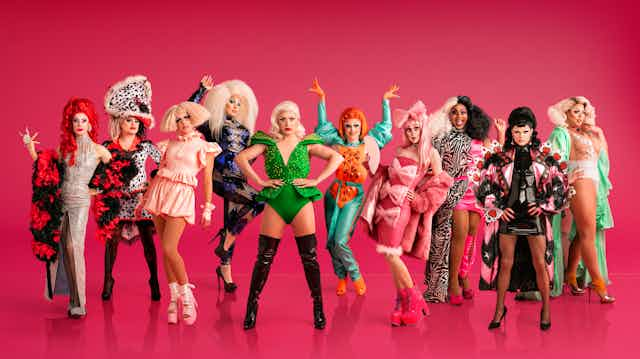Try typing “Yas queen!” or “Shade” or “Don’t Fuck It Up” into a search engine and see what comes up. Most likely, you’ll get a GIF which originated from RuPaul’s Drag Race. First broadcast in the early 2000s as a niche talent show on relatively unknown US cable channel Logo TV, Drag Race is now big business and has moved to a far more visible new home on MTV’s VH1.
A UK version is set to debut on BBC Three in October – and with Canadian and Australian editions in the works, Drag Race has become a cultural juggernaut that is influencing our everyday language and internet behaviour. We should all take notice.

Created by RuPaul Charles – the self-styled “Supermodel of the World”, Drag Race is a loud and proud LGBTQ+ show that subverts the usual trope of typically American talent shows such as Project Runway or America’s Next Top Model, by choosing drag queens as its contestants. On the show, drag queens fight for the crown of “America’s Next Drag Superstar” by competing in singing, dancing, lipsyncing and acting as well as various comedy challenges … and sewing.
Winning – or even just participating in – Drag Race can be life-changing for drag queens. Aside from the crown, America’s Next Drag Superstar wins US$100,000 and travels the world for a year representing the show.
But in the past few years, it has become clear that Drag Race has done way more than entertaining its ever-growing army of fans. It has helped open the door of drag, LGBTQ+ and black queer culture for a mainstream audience – introducing the conventions, habits, rituals and attitudes of these subcultures to the mainstream public.
Drag Race and internet culture
Through Drag Race, the language of drag is not just gaining recognition by a wider public – it is being turned into a new art form through memes, GIFs and content that floods millions of people’s social media feeds.

Drag Race is manna from heaven for content creators and for niche fandoms – groups of die-hard fans that veer away from traditional, mainstream entertainment. In 2018, the show did a crossover episode with America’s Next Top Model. RuPaul’s appearance on Jeopardy, and season nine winner Sasha Velour’s obsession with Riverdale, have left fans begging for new crossovers. Fan blogs have called for Drag Race/American Horror Story or Disney/Drag Race mash-ups.
One of the most famous Drag Race crossovers, however, is Fire WERK With Me, a Facebook group with more than 10,000 members and write-ups in PAPER Magazine. The group blends Drag Race and Twin Peaks by juxtaposing both shows’ characters and quotes through memes, gifs and videos made and posted exclusively by fans, who need to be added and accepted onto the group by moderators.
These tend to contain language and humour that only members of that subculture would be able to understand. The group has been acknowledged by RuPaul in interviews and, recently, by a variety of social media posts.
Shady talk
On Drag Race, language stops being just subcultural “lingo” and is a vehicle for speading and popularising drag slang, which is heavily used, explained and commented on during the show and subsequently adopted by pop culture.
The show’s language borrows from the 1991 New York drag scene documentary Paris Is Burning, depicting the origins and meanings behind culture. Words such as “shade”, in particular, have now become mainstream, used in songs and writing by people outside the black or LGBTQIA+ community.
Originally explained in Paris Is Burning by drag queen Dorian Corey – “Shade is, I don’t tell you you’re ugly, but I don’t have to tell you, because you know you’re ugly. And that’s shade,” - shade is now the ultimate witty, sharp critique adopted across the board.
For American academic Nicholas de Villiers, drag lingo has an educational value, bringing drag into the wider debate to discuss gender, identity and sexuality, opening the discourse to non-LGBTQ+ audiences. And Drag Race makes a point of making words up, to then sum them up or explain them at the end of the season.
These words are often RuPaul’s, but they are also coined by contestants and other judges, like Shangela’s “Halleloo” salute or “No T No Shade” – the inevitable prequel to saying something shady, but true, because there’s no T (truth) without a bit of shade.
Mainstreaming drag
The impact of Drag Race is being felt all over entertainment, so much so that show alumnae such as Willam and Shangela sashayed their way into parts in films such as A Star Is Born.
Others, such as Milk and Violet Chachki, have become runway models for the likes of Marc Jacobs and Jean Paul Gaultier. Comedy queen Bianca Del Rio has sold out Wembley shows, while Shae Coulee, Miss Vanjie or Mayhem Miller have starred in pop videos for major artists including Iggy Azalea.
Drag Race is influencing the way we speak and the content we create, to the extent that it is now becoming the subject of academic papers and studies. And the success of the show demonstrates that today’s viewers don’t just want to sit and watch. They want to evaluate, critique and engage in their own content creation based on the show that creates its own new, newsworthy subcultures and then bleeds on into the mainstream.

